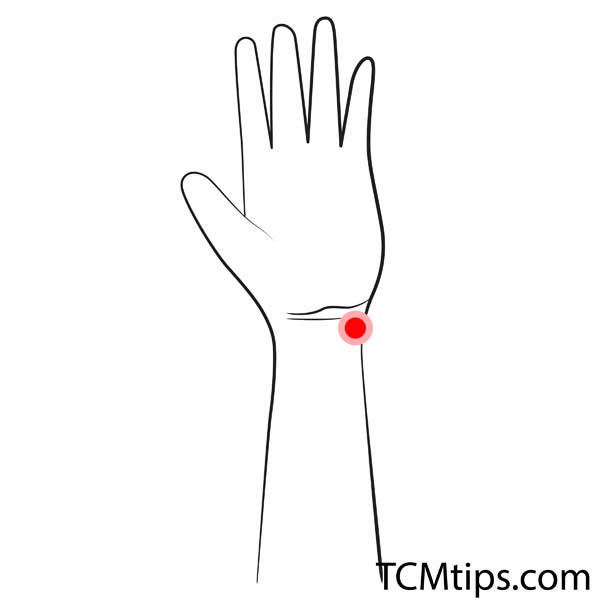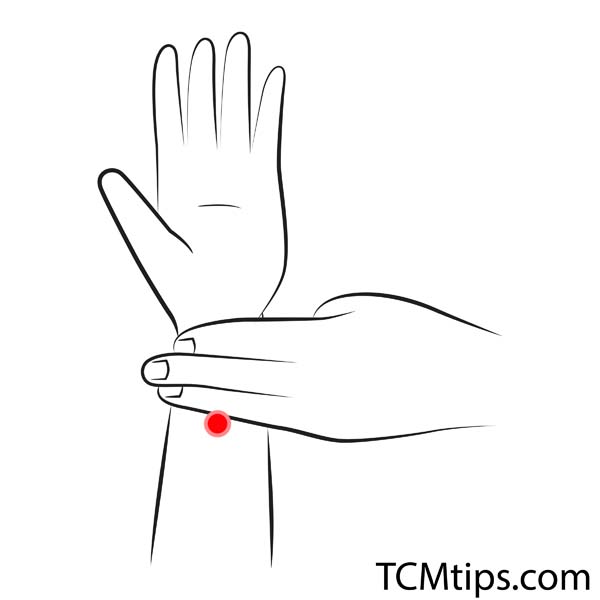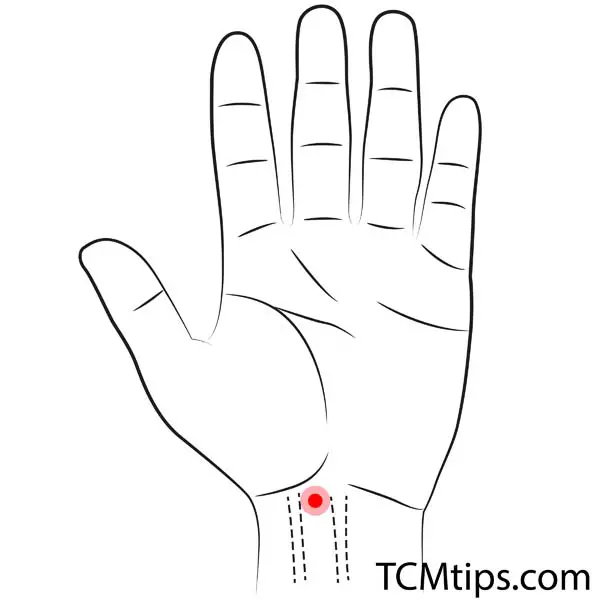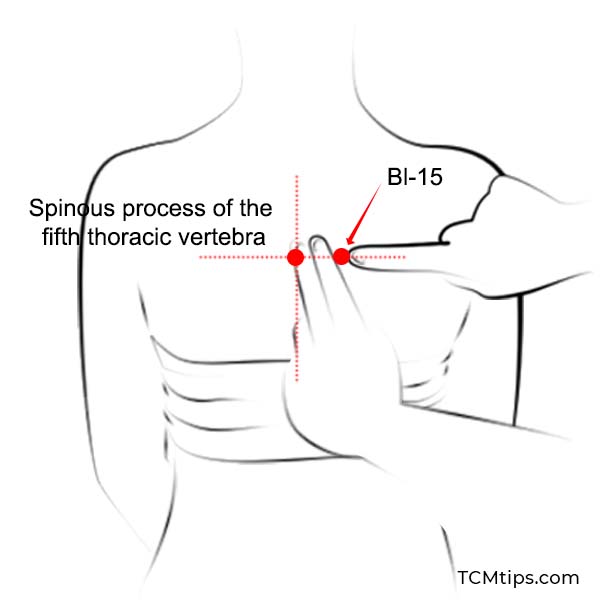Globally, heart disease is the leading cause of death. A whole-foods diet, holistic medicine, and an active lifestyle are all good for heart health, but for an extra “oomph”, think about adding acupressure to your healthcare regimen. Manipulating acupressure points for heart blockage has been shown to reduce the risk of a heart attack, coronary heart disease, and lower excessive blood pressure.
There are certain points on the body that, when manipulated, can help to unblock energy pathways and relieve tension.
Acupoint: HT-7 (Other Names: Heart-7/Shen Men/Spirit Gate)

The acupoint HT-7, which is called “Shen Men” in Traditional Chinese Medicine, translates to “Spirit Gate.” It is one of the acupressure points for heart blockage and is located on the underside of the wrist (palm side), right within the crease along the pinky finger side, just inside the small tendon.
This often-used acupoint is excellent for relaxing and stabilizing the Spirit of the Heart. It aids in the opening and closing of the Spirit Gate. The Shen should be able to flow freely, hence this gate must be able to open and close reliably in order for its function to be performed.
Acupoint HT-7 can help with palpitations, arrhythmia, the symptoms of a heart attack, sleeplessness, stress, and anxiety. To some degree, this acupressure point for heart blockage can be considered for managing mental issues often characterized by uncontrollable tears, desperation, fear, hysteria, or severe tiredness.
The clinical evidence showing a single HT-7 acupressure treatment can control insomnia, tension, anxiety, and withdrawal symptoms are quite remarkable and clinically promising.
A 2015 study evaluating heart rate variance found that HT-7 acupuncture dramatically increased parasympathetic system activity. The HT-7 is also applied as the acupressure point for anger to manage excessive anger and anxiety.
Acupoint: PC-6 (Other Names: Pericardium-6/Nei Guan/Inner Pass)

The acupoint PC-6, which is called “Nei Guan” translates to “Inner Pass.” PC-6 is located on the palm side of the wrist, a few inches toward the body, between the two tendons (palmaris longus & flexor carpi radialis) that run along the center of the forearm.
Place three fingers over your wrist, beginning at the wrist crease, and seek the spot where this line passes between the two tendons.
Acupressure on PC-6 can aid with chest congestion, hypochondrial pain, reduce the risk of a heart attack, and palpitation. PC-6 is a very common and helpful acupressure point for heart blockage, beneficial in managing sleeplessness and relaxing the Shen.
It is also the spot to use if you have nausea or vomiting. In addition, it can be utilized to treat any heart condition such as coronary artery disease. By regulating your circulatory system, PC-6 benefits your heart and lowers your blood pressure. It can also be used to alleviate nausea, migraines, and motion sickness.
According to some 2010 clinical trials, acupressure of PC6 has been shown to upregulate cardiac neurotransmitters and decrease myocardial intracellular calcium levels in rats with myocardial ischemia reperfusion injury, which may contribute to its benefit in treating heart blockage and other health conditions.
According to a published review, the positive effect of acupuncture at PC6 on hypertension, cardiac ischemia, heart blockage, and arrhythmias is attained by reduced sympathetic outflow, mediated by multiple neurotransmitters responsible for controlling cardiovascular responses.
Acupressure point PC-6 is also used as an inner gate acupuncture point to relieve stress.
Acupoint: PC-7 (Other Names: Da Ling/Great Mound)

The acupoint PC-7, which is called “Da Ling” translates to “Great Mound.” PC-7 is located in the middle of the crease of the wrist, between the tendons of palmaris longus and flexor carpi radialis.
PC-7 (Daling), as one of the acupressure points for heart blockage is part of the hand’s pericardium meridian-Jueyin, which is often used for chest pain, stomach cramps, nausea, palpitations, psychosis, seizures, chest and hypochondriac discomfort, wrist joint pain, and coronary heart diseases.
The heart meridian’s Yuan-Source Point is Daling (PC-7), based on the theory that the heart is a muscle said to be the king housing the mind, and the pericardium guards the heart against disease invasion.
As a result of such theory, the points of the Pericardium meridian are frequently used. Daling (PC-7) is a Pericardium meridian that is used as one of the acupressure points to remove heart blockage.
Stimulation techniques are employed in acupressure to balance the energy flow in the body, which can be conducted by physicians, nurses, or even the patients themselves.
Although various studies have demonstrated the effectiveness of this method in improving sleep quality, reducing anxiety and stress, decreasing depression, and changing vital signs in cancer patients, patients with multiple sclerosis, pregnant women, and hemodialysis patients, some other studies have reported the effect of acupressure on physiological parameters as well.
The findings of a study in 2018 indicated that applying acupressure on PC-7 as a nonmedicinal approach could be successful in improving the physiologic characteristics of heart blockage in patients immediately 30 minutes after the intervention. PC-7 is also used as an acupressure point for relaxation.
Acupoint: Bl-15 (Other Names: Urinary Bladder-15/Xin Shu/Heart Transporter)

The acupoint Bl-15, which is called “Xin Shu” translates to “Heart Shu.” Bl-15 is located on the back, 1.5 cm lateral to the lower border of the spinous process of the 5th thoracic vertebra.
Because the heart opens into the tongue and the tongue is the mirror of the heart, Xinshu Bl-15 is utilized for disorders implying oral or tongue ulceration.
The acupoint of Bl-15 strengthens and nourishes the heart, calms the Shen, controls Heart Qi, opens the chest, resolves Blood stagnation, and clears Heart Heat/Fire.
From a TCM approach, Bl-15 is the main point for all heart-related disorders, blood and circulatory-related issues of an excess or deficiency aspect.
Bl-15 enriches the spirit and comforts the Shen – the fundamental center for all heart-related emotional disorders such as palpitations, anxiety, fear, tension, and poor memory. This is especially useful for people who suffer from sleeplessness and other health concerns.
This acupoint also helps with night sweats that are caused by a lack of Heart Qi or Yin.
A single acupressure point is not widely regarded as an empirical method of influencing a TCM diagnostic profile.
Bl-15, on the other hand, is one of the strongest acupressure points for heart blockage and is frequently included in an acupuncture protocol for patients with Heart Qi Deficiency, Heart Yang Deficiency, and/or Heart Yin Deficiency. Acupoint Xin shu Bl-15 is also used as one of the acupressure points for ovary cysts.

Try our Anti-Aging Gua Sha Tool designed to bring out your skin’s natural glow.
Best Gua Sha Product- Anti-Aging: The tool is designed to target 11 specific aging signs such as wrinkles and sagging skin. By following the 7-step routine, users can improve skin firmness and reduce fine lines naturally.
- Enhances Skincare Routine: It works effectively with serums and lotions, boosting absorption and efficacy of skincare products.
- Visible Skin Improvement: Users can expect a smoother complexion, reduced puffiness, and a more youthful appearance.
 P. Sze
P. Sze 

















